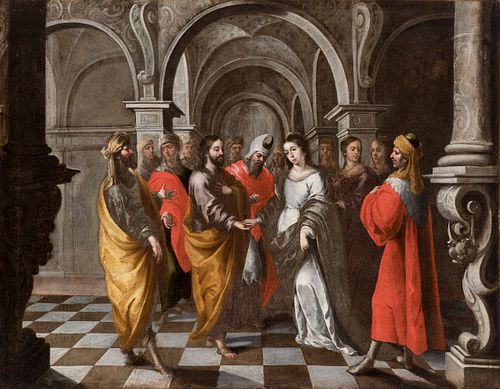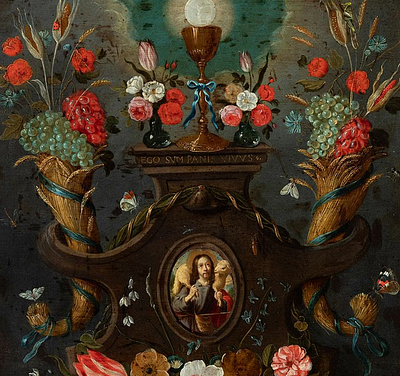MATÍAS DE ARTEAGA Y ALFARO (Villanueva de los Infantes, Ciudad Real, 1633 - Seville, 1703). "The Betrothal of the Virgin" Oil on canvas.
Lot 10
About Seller
Setdart Auction House
Carrer Aragó 346
Barcelona
Spain
Setdart Subastas was born in 2004 and is currently the first online art auction in Spain with solidity, prestige and reliability guaranteed by our more than 60,000 users. Setdart has a young, dynamic and enterprising team ready to successfully manage the purchase and sale of art works through custom...Read more
Estimate:
EUR€5,000 - EUR€7,000
$5,263.16 - $7,368.42
Absentee vs Live bid
Two ways to bid:
- Leave a max absentee bid and the platform will bid on your behalf up to your maximum bid during the live auction.
- Bid live during the auction and your bids will be submitted real-time to the auctioneer.
Bid Increments
| Price | Bid Increment |
|---|---|
| EUR€0 | EUR€10 |
| EUR€200 | EUR€25 |
| EUR€500 | EUR€50 |
| EUR€1,000 | EUR€100 |
| EUR€3,000 | EUR€200 |
| EUR€5,000 | EUR€500 |
| EUR€10,000 | EUR€1,000 |
| EUR€20,000 | EUR€2,000 |
| EUR€50,000 | EUR€5,000 |
About Auction
By Setdart Auction House
Sep 21, 2021
Set Reminder
2021-09-21 10:00:00
2021-09-21 10:00:00
America/New_York
Bidsquare
Bidsquare : 21st September - ARAS JÁUREGUI Private Collection - Old Masters, 19th & 20th Century
https://www.bidsquare.com/auctions/setdart-auction-house/21st-september---aras-j-uregui-private-collection---old-masters-19th-20th-century-7429
Setdart Auction House sofia@setdart.com
Setdart Auction House sofia@setdart.com
- Lot Description
MATÍAS DE ARTEAGA Y ALFARO (Villanueva de los Infantes, Ciudad Real, 1633 - Seville, 1703). "The Betrothal of the Virgin" Oil on canvas. It presents lack of stretcher and slight repainting. Measurements: 86 x 125 cm. We see in this canvas the nuptials of Mary and Joseph in the temple, in a classical composition, centred and balanced, of Italian inheritance. The spouses appear facing each other holding hands, slightly turned towards the spectator and surrounded by witnesses, in front of the priest who appears standing behind them, centring the composition. The scene takes place in a rich interior that is meticulously depicted and worked according to the laws of classical perspective, referring to 16th-century Italian models. The work is very similar to works by Matías de Arteaga, in which classical architecture plays an important role, an example of which is the Wedding at Cana, which belongs to the collection of the Seville Museum of Fine Arts. It should also be noted that the theme of the betrothal of the Virgin was a recurring one in Arteaga's painting, and in fact the Museo del Prado collection contains a work on this theme, similar to this one, whose attribution, according to Angulo, is linked to Arteaga's circle. Matías de Arteaga y Alfaro was a Spanish Baroque painter and engraver. A member of the Sevillian school, he was able to capture and interpret the dual influence of Murillo and Valdés Leal with his own personality. The son of the engraver Bartolomé Arteaga, when he was still a child his family moved to Seville, where he trained in his father's studio and in contact with Murillo, whose influence reveals his early work together with that of Valdés Leal, who settled in Seville the same year Arteaga passed his master painter's examination in 1656. In 1660 he was among the founding members of the celebrated drawing academy promoted by Murillo, among others, of which he served as secretary between then and 1673. In 1664 he joined the Hermandad de la Santa Caridad brotherhood and two years later the Sacramental del Sagrario brotherhood of Seville cathedral, for which he produced a number of works. Around 1680 he is also recorded as working as an appraiser of paintings. He died in 1703, but the inventory of his estate at his death reveals that he lived well off, having a slave and a large, well-furnished house with a medium-sized library containing important books in Latin and Spanish and an engraving studio, as well as over 150 paintings, almost half of which were of religious subjects. Among them were four series of the Life of the Virgin, some of which were expressly said to contain architectural views, such as those in the present work and those in the Museo de Bellas Artes in Seville. The most characteristic feature of his peculiar style is precisely these series of always religious subjects, set in broad landscapes and architectural perspectives taken from prints. Skilful in the creation of these deep, skilfully illuminated perspectives, he was, however, somewhat clumsy in his treatment of the figures and their bodily expressions. Arteaga is represented in the aforementioned Sevillian museum, various Sevillian churches including the cathedral and the Museo Lázaro Galdiano, among others.
- Shipping Info
-
In-house shipping available. Please inquire at admin@setdart.com.
-
- Buyer's Premium



 EUR
EUR CAD
CAD AUD
AUD GBP
GBP MXN
MXN HKD
HKD CNY
CNY MYR
MYR SEK
SEK SGD
SGD CHF
CHF THB
THB

















